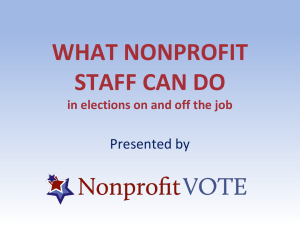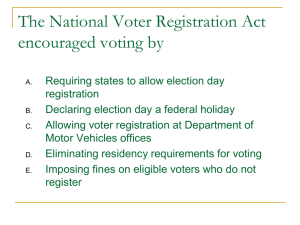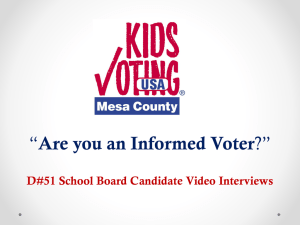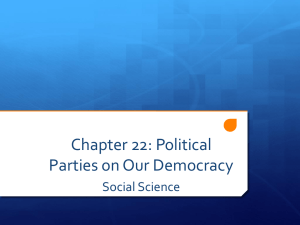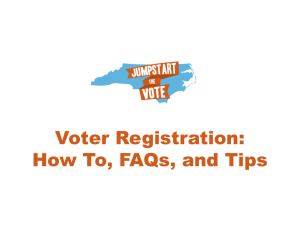HOSTING A CANDIDATE FORUM
advertisement
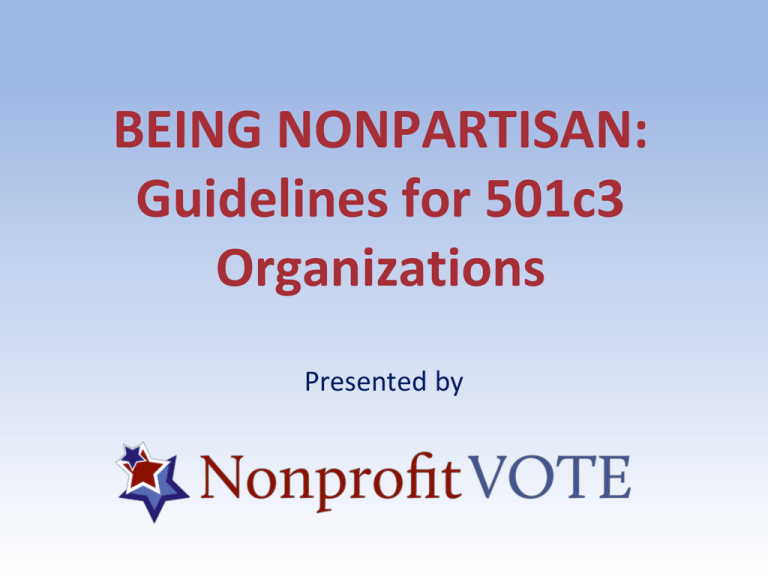
BEING NONPARTISAN: Guidelines for 501c3 Organizations Presented by A national hub of voter engagement resources and trainings to help nonprofits integrate nonpartisan voter participation into ongoing activities and services. The official voter participation partner of the National Association of Secretaries of State for the nonprofit sector About TODAY’S PRESENTER George Pillsbury Executive Director Nonprofit VOTE Who GETTING READY FOR THE MIDTERM • One in four voting eligible Americans are not registered to vote (50 million) • 34 million fewer people will vote in midterm, disproportionately newer voters • Changes in election laws impact voters served by nonprofits 2014 Midterm WHY NONPROFITS, WHY VOTING • Access to underrepresented populations • Trust and respect in our communities • Building clout for the work we do and people we serve • Getting our ideas in front of candidates Why Nonprofits NEW RULES FOR 501(c)(4)s? • Aimed to limit use of 501(c)(4) nonprofits as funnel for partisan campaign cash • Took overbroad approach – inspired a record 143,000 comments • Only affects 501c4 organizations – and no impact until at least 2015 Being Nonpartisan AGENDA Being Nonpartisan: The Basic Guidelines o Voter Registration o Voter Education o Engaging Candidates o Ballot Measures o Get Out The Vote Issue Advocacy Staff Activities on personal time More Resources Agenda BEING NONPARTISAN: Basic Guidelines for 501(c)3)s WHAT’S PARTISAN - THE ONE RULE A 501(c)(3) nonprofit organization may not support or oppose a candidate for public office. May not – • Endorse candidates • Donate money or resources to candidates • Rate candidates on single issues Being Nonpartisan RANKING - SCORECARDS Being Nonpartisan RANKING – CANDIDATE COMPARISONS • Ok to compare candidates on the issues in candidate questionnaires, voter guides • Keep your opinion out of it – don’t indicate the right position in the printed guide or on the same page of the website Being Nonpartisan WHAT NONPROFITS CAN DO Nonprofits may conduct nonpartisan voter engagement activities to educate the public and help them participate in elections, including May – • Register Voters • Educate Voters • Get Out The Vote (GOTV) • Hold Candidate Forums Being Nonpartisan VOTER REGISTRATION VOTER REGISTRATION Common Nonpartisan Activities • Promote voter registration – Announce deadlines – Provide information on where and when to register to vote • Conduct voter registration – Table in your lobby – Register voters at events – Do a voter registration drive Voter Registration VOTER REGISTRATION: Guidelines • No endorsements: May not suggest which party to join or candidate to vote for • Know your state’s rules: Use our “Vote in Your State” guide. Coordinate with your local election office Voter Registration VOTER EDUCATION VOTER EDUCATION: The Process of Voting • How, where and when to vote – Early Voting – Voter ID Needed – Civic Education Voter Education VOTER EDUCATION: Candidates and Issues • Sample Ballots and Voter Guides • Candidate Questionnaires Stay Neutral when mentioning the names of candidates Voter Education VOTER EDUCATION Candidate Questionnaires • Ask questions on a range of topics • Not just yes or no. Let candidates explain view, but give a word limit • Send it to all candidates in the race • If a candidate doesn’t respond - may list “no response” or use official statements from the candidate’s website Voter Education ENGAGING CANDIDATES CANDIDATE ENGAGEMENT 3 Ways to Connect to Candidates on a nonpartisan basis • Invite candidates to an event • Sponsor a candidate forum • Send candidates your policy ideas Engaging Candidates CANDIDATES APPEARANCES • Invite all the candidates running for the same office • Treat candidates as guests – no campaign materials allowed • Remind audience it’s a nonpartisan event and thank candidates for attending Elected officials may be invited to speak in a non-candidate capacity. Engaging Candidates CANDIDATE FORUMS • Cover a range of issues or topics within your own issue area • Provide equal time for the candidates • Ask all candidates to attend • Have at least 2 candidates to be a “forum” Engaging Candidates CANDIDATE ENGAGEMENT RESOURCES BALLOT MEASURES BALLOT MEASURES Ballot measures are about laws or constitutional amendments • Activity on ballot measures is lobbying. It’s influencing the passage or defeat of a law– not the election or defeat of a candidate • 501c3 nonprofits may work for or against a ballot measure as a lobbying activity Ballot Measures GET OUT THE VOTE AND ELECTION DAY GET OUT THE VOTE 501(c)(3)s may • Make the election visible • Provide voter assistance • Conduct get-out-the-vote drives • Remind staff and constituents to vote Get Out The Vote ELECTION DAY • Give staff time off: To vote or do nonpartisan election activities • Rides to the polls: No campaign materials on the vehicles • Celebrate Democracy: Make Election Day special. Have a party. Election Day ISSUE ADVOCACY AND MORE ISSUE ADVOCACY “501(c)(3) organizations may take positions on public policy issues, including issues that divide candidates in an election for public office.” (Internal Revenue Service 2006) Issue Advocacy ISSUE ADVOCACY Factors to consider • Increasing advocacy activities during the election season could be partisan • History of work on an issue in the past is a key nonpartisan factor • Responding to an external event is ok and nonpartisan Issue Advocacy WHAT STAFF CAN DO • Nonprofit staff may engage in partisan activities, such as supporting a candidate, outside of normal work hours • Distinguish personal use of social media from that of your nonprofit Staff Activities www.nonprofitvote.org info@nonprofitvote.org 617.357.VOTE (8683) www.nonprofitvote.org Nonprofit VOTE 89 South Street Suite 203 Boston, MA 02111 George Pillsbury gpillsbury@nonprofitvote.org Julian Johannesen julian@nonprofitvote.org
